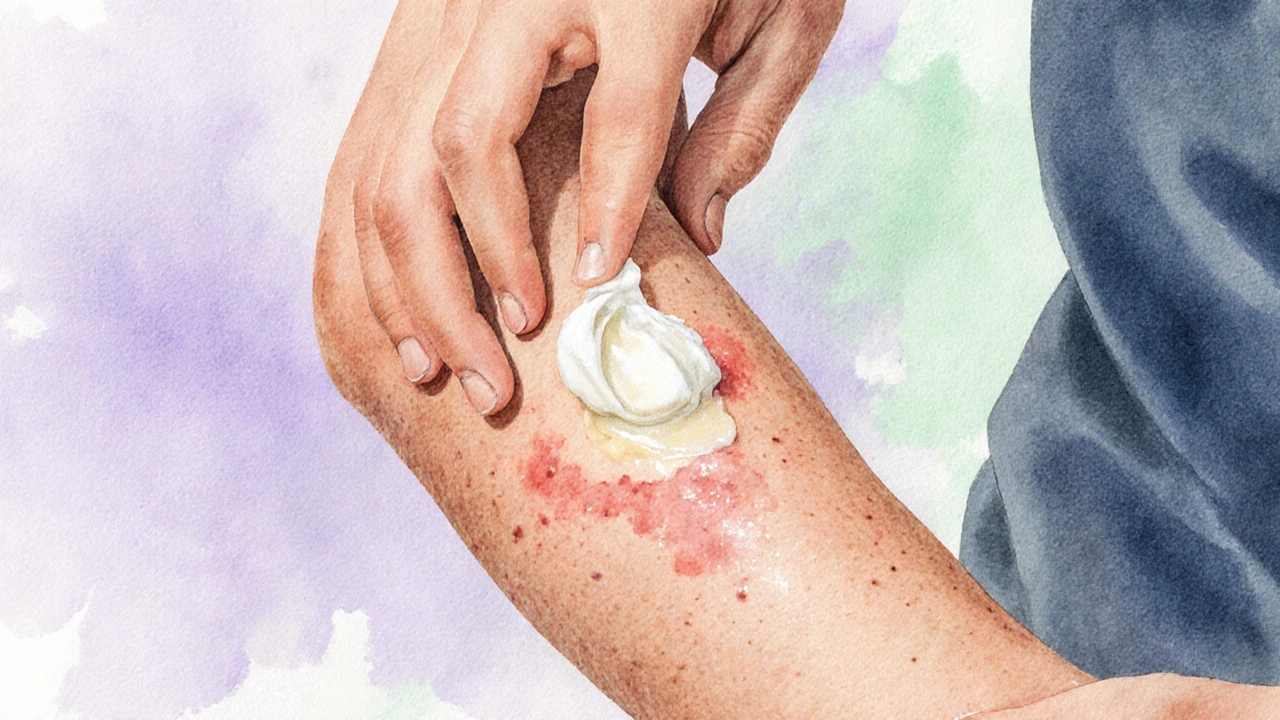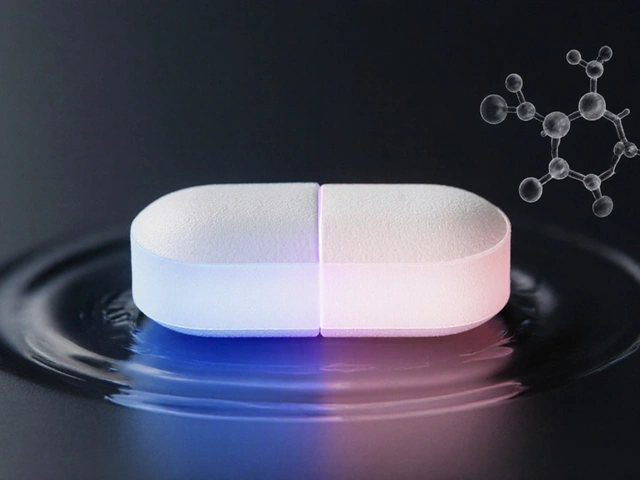Eczema is a chronic inflammatory skin condition that causes itching, redness, and dry patches. It affects people of all ages, but symptoms often start in childhood. Understanding why the skin blows up and how to keep it calm is the first step toward lasting comfort.
What Drives Eczema? The Biology Behind the Itch
At its core, eczema is a problem with the Skin Barrier the outermost layer of skin that locks in moisture and blocks irritants. When this barrier is weak, water evaporates faster and allergens slip through, sparking an immune response.
The Immune System a network of cells that defends the body against infection overreacts to these breaches, releasing inflammatory chemicals like cytokines. That cascade creates the characteristic redness and itch.
Key Players: Names and Definitions
- Atopic Dermatitis the medical term most clinicians use for eczema, highlighting its association with other atopic conditions such as asthma and hay fever.
- Moisturizer a topical product designed to restore and maintain skin hydration, often the first line of defense.
- Topical Corticosteroid a prescription cream or ointment that reduces inflammation quickly.
- Calcineurin Inhibitor a non‑steroid cream (e.g., tacrolimus) that modulates immune activity without thinning skin.
- Antihistamine an oral medication that eases itching by blocking histamine receptors.
Common Triggers: What Sets Off a Flare‑Up?
Even with a solid skin barrier, certain irritants can provoke a flare. Typical trigger factors include:
- Harsh soaps or detergents that strip natural oils.
- Extreme temperatures - both dry heat and cold wind.
- Allergens such as pet dander, pollen, or certain foods (e.g., eggs, nuts).
- Stress - cortisol spikes can aggravate immune responses.
- Scratching - creates micro‑injuries that let more irritants in.
Identifying personal triggers often involves a diary: note what you ate, wore, and felt each day, then look for patterns.
Step‑by‑Step Management Plan
- Repair the barrier: Apply a fragrance‑free Moisturizer at least twice daily, especially after bathing. Look for ingredients like ceramides, hyaluronic acid, and glycerin.
- Control inflammation: Use a Topical Corticosteroid for acute flares. Start with a low‑potency steroid (e.g., hydrocortisone 1%) on mild patches; reserve high‑potency options (e.g., clobetasol) for short‑term, limited‑area use.
- Consider steroid‑sparing options: If you need long‑term control, discuss Calcineurin Inhibitor therapy with your dermatologist. These are ideal for delicate areas like the face.
- Ease itching: An oral Antihistamine (e.g., cetirizine) can help at night, reducing the urge to scratch.
- Eliminate triggers: Replace harsh soaps with syndet bars, use humidifiers in dry climates, and keep a food/skin journal.

Comparing Top Treatment Options
| Treatment | Mechanism | Typical Onset | Side‑Effect Profile | Prescription? |
|---|---|---|---|---|
| Moisturizer | Restores lipid barrier | Immediate hydration | Rare irritation if fragrance present | No |
| Topical Corticosteroid | Suppresses inflammatory cytokines | Hours to days | Skin thinning, stretch marks (high potency) | Yes |
| Calcineurin Inhibitor | Blocks T‑cell activation | Days | Transient burning, rare lymphoma concerns | Yes |
| Antihistamine | Blocks histamine receptors | 30‑60min (oral) | Drowsiness (first‑gen), dry mouth | Usually No (OTC) |
Related Concepts and How They Interact
Understanding eczema also means looking at the broader skin‑health ecosystem. The Microbiome - the community of bacteria living on our skin - can become imbalanced during flares, allowing Staphylococcus aureus to dominate and worsen inflammation. Probiotic‑rich moisturizers aim to restore a healthy mix.
Another piece is Psychodermatology, the study of how stress and mental health influence skin conditions. Techniques like mindfulness, CBT, or even simple breathing exercises have been shown in clinical trials (e.g., 2022 Dermatology Journal) to lower flare frequency.
Lastly, Phototherapy (narrowband UVB) is a third‑line option for stubborn cases, especially when multiple topical agents have failed. It works by dampening overactive immune cells without systemic medication.
Living with Eczema: Everyday Hacks
- Keep nails short to limit damage from scratching.
- Wear soft, breathable fabrics like cotton; avoid wool or synthetic blends that can irritate.
- Use a humidifier set to 40‑60% relative humidity in winter.
- Take lukewarm showers (no longer than 10minutes) and immediately pat skin dry, then seal in moisture with a thick cream.
- Carry a travel‑size fragrance‑free moisturizer for unexpected flare‑ups.
When to Seek Professional Help
If you notice any of the following, schedule a dermatologist visit:
- Rapid spreading of red, painful patches.
- Signs of infection: pus, crusting, fever.
- Failure to improve after two weeks of consistent moisturization.
- Severe itching that disrupts sleep or daily activities.
Dermatologists can perform patch testing to pinpoint allergens, prescribe stronger steroids, or explore systemic options like dupilumab (an injectable biologic targeting IL‑4/IL‑13 pathways) for severe atopic dermatitis.

Frequently Asked Questions
What is the difference between eczema and atopic dermatitis?
Eczema is the umbrella term for itchy skin conditions. Atopic dermatitis is the most common form, linked to a genetic tendency toward allergies. In everyday talk the two are often used interchangeably.
Can diet really affect eczema?
For some people, certain foods trigger flares, especially those with existing food allergies. Keeping a food‑symptom diary and working with an allergist can uncover hidden culprits.
How often should I apply moisturizer?
Ideally twice daily - right after bathing and before bed - and anytime the skin feels tight. During a flare, add a third application in the afternoon.
Are topical steroids safe for long‑term use?
Low‑potency steroids used intermittently are generally safe. Continuous high‑potency use can thin skin and cause other side effects, so doctors usually rotate with steroid‑sparing agents like calcineurin inhibitors.
What is dupilumab and when is it prescribed?
Dupilumab is a biologic injection that blocks key inflammatory signals (IL‑4/IL‑13). It’s reserved for moderate‑to‑severe atopic dermatitis that doesn’t respond to topical treatments or phototherapy.









Comments (19)
Alan Larkin
September 26, 2025 AT 17:17 PMFirst off, eczema isn’t just "dry skin" – it’s a complex immunological disorder that stems from a compromised skin barrier.
The barrier’s lipid matrix loses its integrity, allowing transepidermal water loss and entry of allergens.
When that happens, keratinocytes release cytokines that rally T‑cells into an inflammatory cascade.
This cascade manifests as the characteristic redness, papules, and relentless itching.
Genetics play a substantial role; filaggrin gene mutations are among the most well‑documented risk factors.
However, environmental triggers such as harsh soaps, low humidity, and stress can exacerbate the condition even in genetically predisposed individuals.
The first line of defence, as the guide mentions, is a robust moisturiser rich in ceramides, glycerin, and hyaluronic acid.
Applying it immediately after a lukewarm shower seals in moisture while the skin is still damp.
For acute flares, low‑potency topical corticosteroids like hydrocortisone 1 % are perfectly adequate and minimise the risk of skin atrophy.
If you need something stronger, reserve a medium‑potency steroid for a short period and taper as soon as the lesions improve.
Non‑steroidal options such as calcineurin inhibitors (tacrolimus or pimecrolimus) are invaluable for sensitive areas like the face and neck.
They avoid the thinning side‑effects of steroids while still suppressing T‑cell activation.
Oral antihistamines can aid sleep by blunting the nocturnal itch, but they don’t address the underlying inflammation.
For refractory cases, biologics like dupilumab target specific interleukins (IL‑4/IL‑13) and have revolutionised severe atopic dermatitis management.
In practice, keep a symptom diary, stay consistent with moisturisation, and don’t hesitate to seek dermatologist input when the skin refuses to cooperate 🙂.
John Chapman
September 30, 2025 AT 17:17 PMWhile the guide superbly outlines the barrier‑repair paradigm, it omits a rigorous discussion of the cutaneous microbiome, which-according to recent high‑throughput sequencing studies-exerts a decisive modulatory effect on inflammatory pathways. One must therefore integrate probiotic‑enriched emollients into the regimen, lest we ignore a pivotal axis of pathogenesis.
Tiarna Mitchell-Heath
October 4, 2025 AT 17:17 PMStop fiddling around with vague "soft soaps"; you need to dump every synthetic surfactant from your routine immediately, because they are the single biggest culprits behind persistent flares, and if you don’t act now your skin will never recover.
Katie Jenkins
October 8, 2025 AT 17:17 PMTo clarify, the assertion that "all synthetic surfactants are evil" is an over‑generalisation; while many conventional detergents strip lipids, there exist clinically‑validated syndet bars formulated with mild amphoteric agents that preserve the barrier while effectively cleansing. Moreover, a balanced approach-alternating between a gentle cleanser and a ceramide‑rich moisturiser-optimises epidermal recovery without compromising hygiene.
Jack Marsh
October 12, 2025 AT 17:17 PMIt is imperative to acknowledge that the prevailing emphasis on moisturisation, albeit beneficial, may inadvertently mask deeper immunological dysregulation; consequently, patients who rely solely on emollients without concomitant immunomodulatory therapy risk chronicity and diminished quality of life.
Terry Lim
October 16, 2025 AT 17:17 PMRelying only on creams is a lazy shortcut that prolongs suffering.
Cayla Orahood
October 20, 2025 AT 17:17 PMEveryone pretends the "simple skin barrier fix" is the ultimate cure, yet the pharma giants quietly push pricey prescription steroids to keep us dependent; the truth is hidden beneath layers of corporate spin, and only the truly vigilant can break free from this orchestrated cycle of profit and perpetual itch.
McKenna Baldock
October 24, 2025 AT 17:17 PMFrom a phenomenological standpoint, the skin operates as an embodied interface between self and environment; nurturing it through mindful routines-such as breath‑synchronised moisturisation-can transform the act of care into a form of contemplative practice that transcends mere symptom management.
Roger Wing
October 28, 2025 AT 17:17 PMHonestly the whole "moisturiser first" hype is overrated most people just need to stop scratching and the skin will fix itself
Matt Cress
November 1, 2025 AT 17:17 PMOh sure, because we all have endless patience to just *wait* for our skin to magically heal itself while we ignore the science-real bright idea 🙄
Andy Williams
November 5, 2025 AT 17:17 PMThe distinction between atopic dermatitis and other eczematous conditions lies primarily in the presence of a hereditary atopiform predisposition, which can be confirmed through pedigree analysis and specific IgE profiling.
Paige Crippen
November 9, 2025 AT 17:17 PMOne must consider that many of the cited studies are funded by dermatological corporations, raising questions about the impartiality of the treatment recommendations presented.
Ted Mann
November 13, 2025 AT 17:17 PMHey folks, think of your skin like a garden: you can’t just toss water on it and expect weeds to disappear; you need the right soil (barrier lipids), proper sunlight (balanced UV exposure), and occasional pruning (targeted anti‑inflammatory therapy) to keep it thriving.
Brennan Loveless
November 17, 2025 AT 17:17 PMWhile the garden analogy is useful, let’s not forget that many of the “modern” skincare solutions are exported from overseas, and there’s merit in revisiting home‑grown, plant‑based formulations that respect our native dermatological heritage.
Vani Prasanth
November 21, 2025 AT 17:17 PMRemember, consistency is key-make moisturizing a non‑negotiable part of your morning and evening routine, and celebrate each small improvement; progress may be gradual, but every step forward builds lasting resilience.
Maggie Hewitt
November 25, 2025 AT 17:17 PMOh, absolutely, because “just be consistent” has solved every chronic condition since the dawn of medicine-if only we could all wave a magic wand and make eczema vanish, right?
Mike Brindisi
November 29, 2025 AT 17:17 PMLook the real issue is you’re ignoring the role of diet so stop blaming the weather and start cutting out dairy and gluten for real results
Shaquel Jackson
December 3, 2025 AT 17:17 PMSure, diet changes sound great on paper but actually rearranging meals every day is exhausted 😒
Tom Bon
December 7, 2025 AT 17:17 PMIt is advisable to maintain a structured regimen that incorporates both barrier repair agents and evidence‑based anti‑inflammatory medications, thereby ensuring a comprehensive approach to disease management.